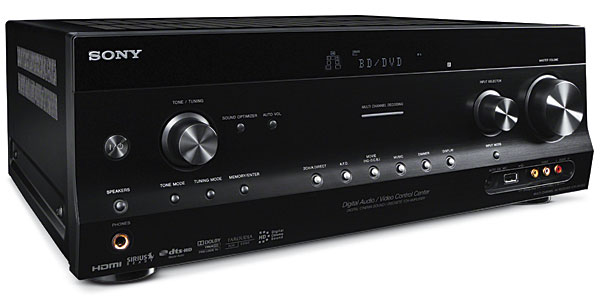Sony STR-DN1020 A/V Receiver Page 2
 Associated equipment
for this review included five Paradigm Reference Studio 20 v.4 speakers, Oppo BDP-83SE universal disc player, Rega Planar 25 turntable, Shure M97xE cartridge, and Bellari VP530 tube phono preamp. All movie demos were Blu-ray Discs with DTS-HD Master Audio soundtracks.
Associated equipment
for this review included five Paradigm Reference Studio 20 v.4 speakers, Oppo BDP-83SE universal disc player, Rega Planar 25 turntable, Shure M97xE cartridge, and Bellari VP530 tube phono preamp. All movie demos were Blu-ray Discs with DTS-HD Master Audio soundtracks.
Down in the Cave
Sanctum, the story of a spelunking expedition gone awry, gave the Sony a chance to show its command of the basics. Dialogue was clear, and the orchestral texture, including a keening African vocalist, was attractive. While the soundtrack wasn’t
especially assaultive, I still scoped out the low-volume listening possibilities. This AVR has no licensed low-volume modes along the lines of Audyssey Dynamic Volume or Dolby Volume. Instead, it offers a generic Auto Volume setting that operates only with Dolby Digital, DTS, or PCM signals—presumably a holdover from the waning DVD era. If you’re playing Blu-ray with DTS-HD Master Audio or Dolby TrueHD, the alternative is a Sound Optimizer control that Sony deemed worthy of its own remote control button. It firmed up bass, especially in a scene with a violent gush of water. It also thickened the midrange, though not in a way that helped dialogue.
True Grit (2010), as a Western, has a lot of open-air dialogue, usually with little reverb except for the occasional resounding gunshot. Voices had a slightly processed sound, possibly as a consequence of the DCAC Engineer setting and its mimicking of the Sony listening room. The effect was subtle and not at all unpleasant. I would imagine a purist would prefer DCAC’s Full Flat setting, and for long-term use, that would be my choice—I like the character of my room. With different speakers and a different room, your mileage may vary.
For Cirque du Freak: The Vampire’s Assistant, I tried Sony’s HD-D.C.S. (HD Digital Cinema Sound) mode. It comes in three flavors: Dynamic, Theater, and Studio. The first two are intended to evoke mastering studios, with Dynamic emphasizing reflections and Theater mixing reflections and reverb. Sony recommends Theater if your room has little reverb of its own. Studio is the no-frills setting. Despite its name, Studio is the only mode not intended to re-create a mastering studio. I ended up preferring Theater—it added a little spice but didn’t lay it on with a trowel. Again, the purist-approved choice would have been Studio.
Danish Strings, Odd Times
The Danish composer Anders Koppel’s String Quartets and Mezzo Saxophone Quartet arrived on a multichannel SACD featuring the Sjælland String Quartet and, on the latter work, saxophonist Benjamin Koppel. The 5.1 mix made appropriate use of the center channel and let the soundfield breathe toward the rear without getting stranded there. Possibly due to Sony’s various layers of processing, the string sound was full-bodied and rich, not etched
or thin. Passages of unison playing blended beautifully; otherwise, the instruments were separately audible.

King Crimson’s Starless and Bible Black, even on tube-mellowed vinyl, goes for the throat right from the opening track. It’s an odd blend of studio and live tracks, the former claustrophobically lacking in reverb, and the latter with a slightly richer ambience. This album demands to be played loud. The Sony supported this imperative, keeping up with the timbral subtleties of both Robert Fripp’s mercurial guitar lines and John Wetton’s monster bass. The latter made the use of the Analog Direct and 2-Channel Stereo modes impossible as they don’t include the subwoofer—the bass and Bill Bruford’s mighty kick drum cried out for bass management. I used the Auto Format Direct or “A.F.D. Auto” soundfield mode. This is a two-channel listening mode for music that includes bass management to redirect low frequencies to the subwoofer. The need for bass management continued with Dave Brubeck Quartet’s Time Further Out. Eugene Wright’s bass has always been mixed on the low side, and through two channels, it tended to disappear, so A.F.D. 2.1 was the better choice for this selection as well. It also lent greater weight to the pianist’s left hand. This follow-up to the quartet’s famous Time Out is a celebration of odd time signatures, with two tunes in 3/4, one in 4/4, two in 5/4, one in 6/4, one in 7/4, one in 8/8, and one in 9/8. I had fun counting along.
The Sony STR- DN1020 is a good-sounding A/V receiver that makes life especially easy for Apple enthusiasts, thanks to the free dock, iDevice-hip front-panel USB jack, and control app. One thing it is missing is a way to push media to the AVR without using the Sony’s own interface, such as AirPlay or Windows 7 Play To technology. Another weak point is the primitive Sound Opti- mizer low-volume listening mode—if Sony doesn’t want to do business with Audyssey, it should at least license Dolby Volume. On the plus side, Sony goes further than most manufacturers to make your listening room sound like a mastering studio. As usual, Sony bravely blazes its own path.
- Log in or register to post comments




































































